
Arvin Vohra
EpiPen is basically early 1900s technology. It’s a syringe containing adrenaline, attached to a spring. During the last couple of years, the price has increased from $100 per device to $600. Even though production cost has gone down to $10 per device, the price has gone up.
Laser eye surgery, on the other hand, is futuristic technology. During the last few years, its price has declined from several thousand dollars per eye, to a few hundred. In other words, the price of the futuristic technology that requires both advanced technology and skilled labor has gone down to the price of 100-year-old tech that requires no skilled labor to use.
Why? There is less government involvement in laser eye surgery. Medicare and Medicaid don’t cover it. Government-regulated insurance doesn’t cover it.
Without tax-funded subsidies, laser eye surgery has to compete on price. Innovators have found ways to improve quality while reducing cost. With EpiPen, cronyist leeches have just raised prices on the same thing.
Imagine if the price competition of a true, unsubsidized, free market in health care lowered the cost of everything. Without government keeping prices high, drugs that now cost $80 might cost 80 cents. Services that cost $2,000 might cost $20.
If we further remove border protections for big pharma, and stopped preventing people from buying medicines from other countries, the price competition would intensify. Americans could pay the same low prices for identical drugs that people in other countries already do. Healthcare would be truly universal, because it would be easily affordable.
Let’s separate healthcare and state, lower costs, and improve innovation. Let’s make universal healthcare a reality, not through taxation and theft, but through lower prices.
In liberty,
Arvin Vohra
Vice Chair
Libertarian Party

